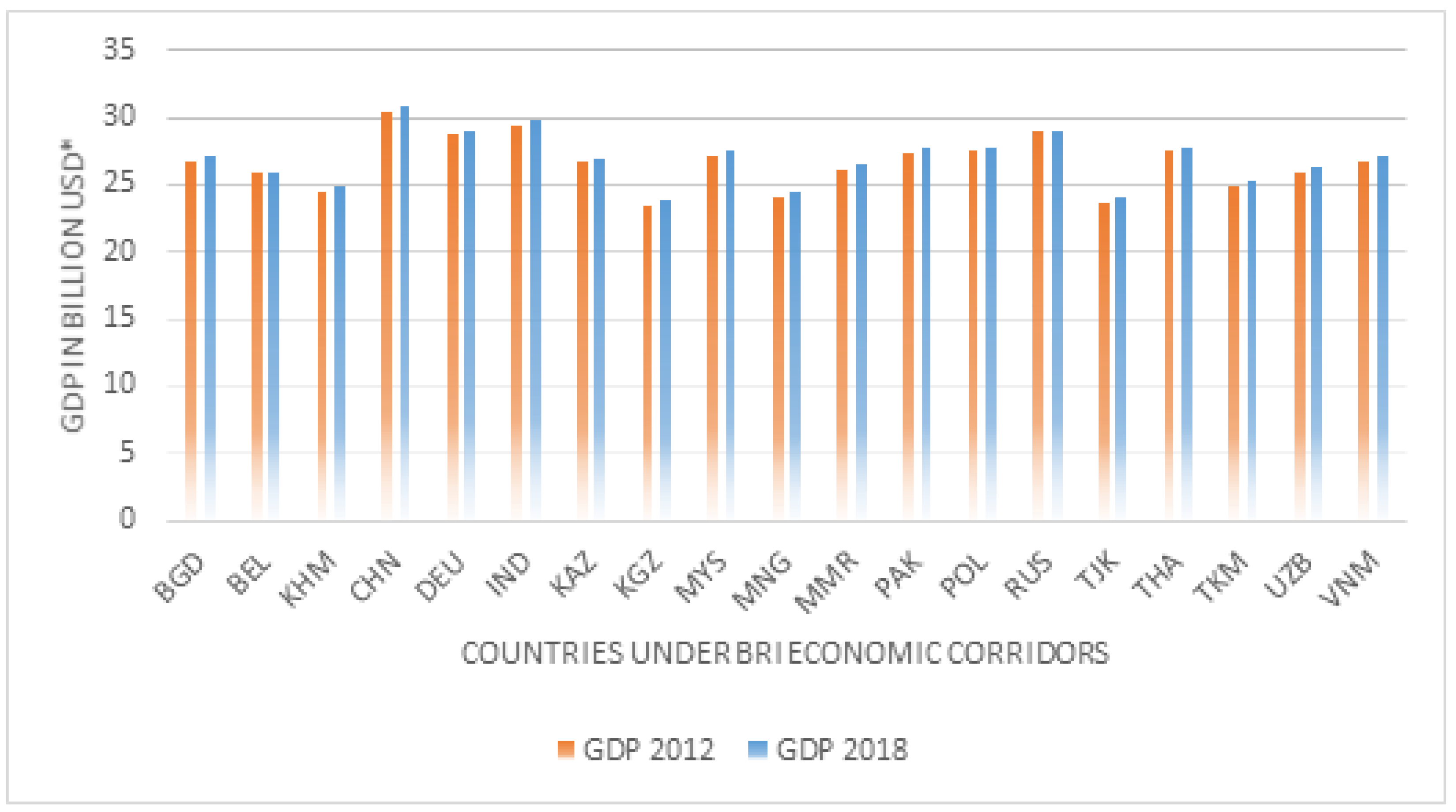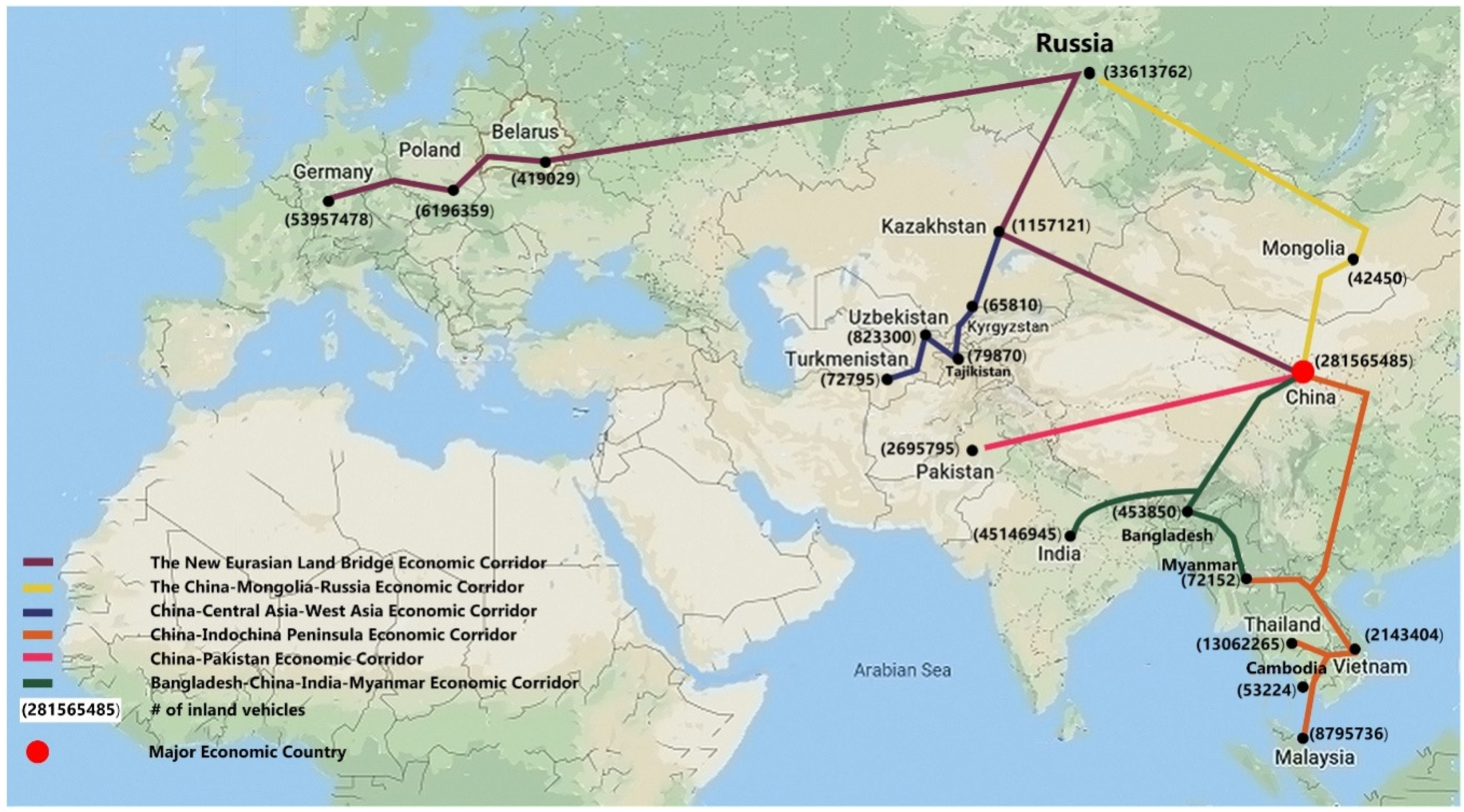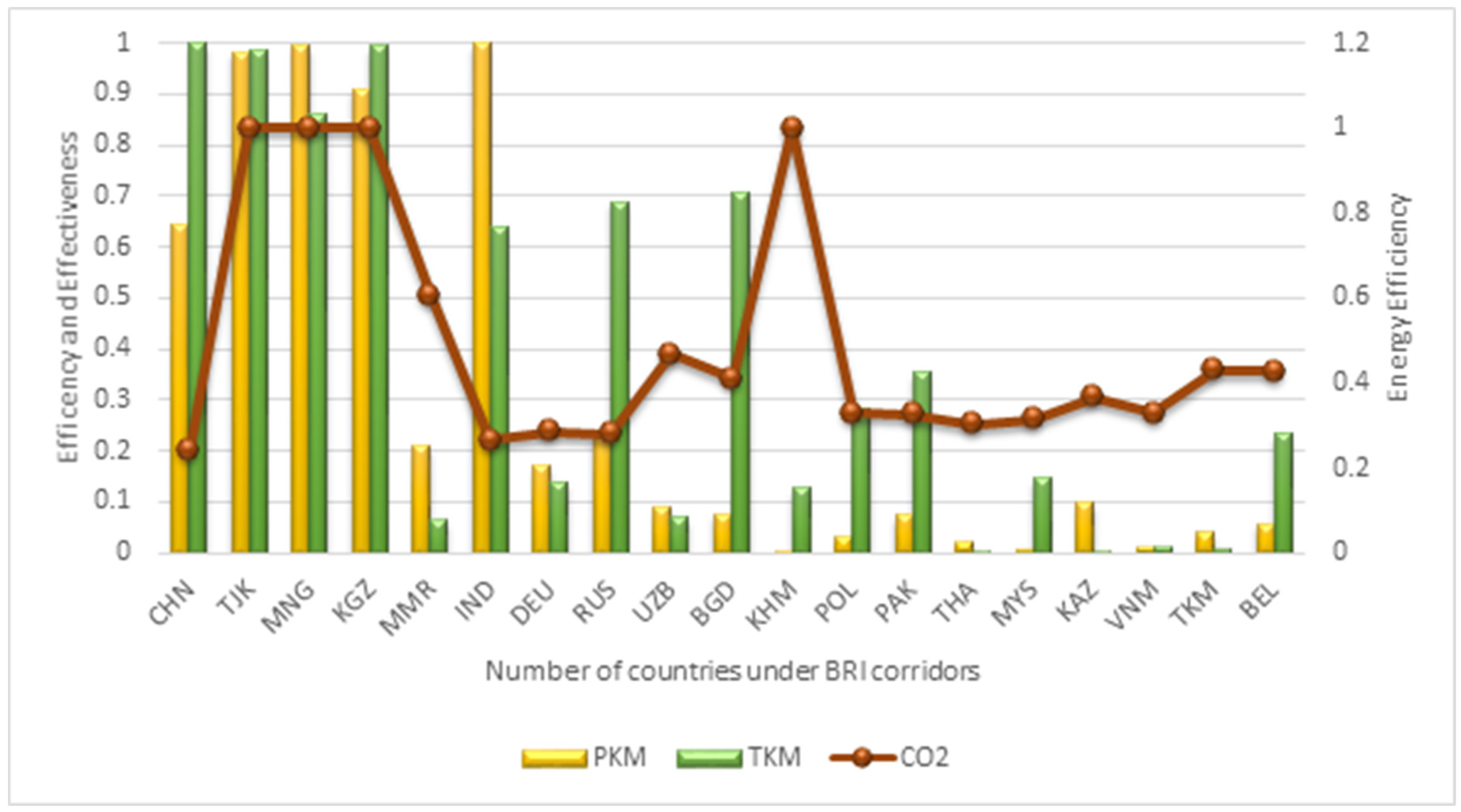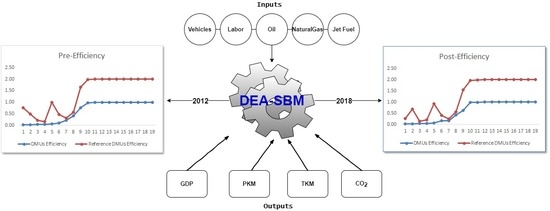In the immense literature of energy efficiency, scholars have used some adverse factors, such as NO
x, SO
2, SO
3, and CO
2 emissions, to estimate the efficiency of transport energy [
6,
13,
18,
19]. Increasing the efficiency of the transport sector without considering harmful greenhouse gases may lead to unreliable results. Among all the emission factors mentioned above, the amount of CO
2 has the greatest impact on the environment; hence, it can be a better measure of energy efficiency in transportation. According to the U.S. Environmental Protection Agency (
www.epa.gov), carbon dioxide emitted through coal, natural gas, and oil accounts for about 81% of global greenhouse gases. It is evident that CO
2 is the most suitable factor in GHG that must be considered to obtain effective results. Therefore, the literature review includes two parts. The first is related to the impact of transport energy on efficiency mainly considering CO
2 emissions and the second part is about the DEA methods used for energy efficiency assessment.
2.1. Impact of Transport Energy
Inevitably, the impacts of transportation energy on the environment, society, and national economy are so great that it has become the focus of many researchers. For instance, Solaymani [
20] (2019) studied CO
2 emission patterns in the transport sector of the seven largest carbon-emitting economies. He showed that China, the United States, Russia, Canada, India, and Brazil had increased emissions rates between 2000 and 2015, but it is declining in Japan. The author believes that limited private car ownership and an optimized energy structure can reduce carbon emissions [
20]. Liu et al. [
21] assessed the energy consumption and emissions of China’s transportation by 2050. The results show that by 2050, energy consumption may reach 509-1284 MTCE (Million Tons of Coal Equivalent), which will cause health and economic losses. Talbi [
22] analyzes the change in CO
2 emissions from the Tunisian transport industry and shows the main effects of energy efficiency and fuel rates on reducing CO
2 emissions. Zhang et al. [
23] estimated the direct energy effect of highway passenger transport in China. They revealed that with the increase of kilometers, the direct rebound effect in different regions of China would be different. However, the effectiveness of central regions is often better than that of other regions. Similar to Solaymani [
20], Lipscy and Schipper [
24] also used the Japanese transportation industry as an example to show that compared with developed economies, Japan stands out in terms of the model structure instead of model energy intensity.
The economic impact has a strong positive correlation with carbon intensity, which requires special attention to reduce cost and protect the environment in terms of GHG reductions [
25]. The most recent study of Mariyakhan et al. [
19] showed vivid evidence. They found that an increase in human-based technology transfer would increase CO
2 emissions, while a decrease in infrastructure-based technology transfer would reduce emissions. They further established that innovation and infrastructure development with an increased absorptive capacity could help lessen the carbon intensity of China and the US. Li et al. [
26] found that the average CO
2 emissions of suburban commercial centers were 6.94% and 26.92%, which are higher than those of urban commercial centers. The CO
2 emissions of wholesale centers were nearly three times less than those of the inner-city commercial centers. On the other hand, Brătucu et al. [
27] recommended information campaigns to raise awareness about the importance of energy usage for the sustainable economic development of Romania. Mofleh et al. [
28] found that more than 80% of energy consumption is fuel based, and its demand increases over time. They discussed the level of emissions from energy consumption and analyzed its impact patterns in Malaysia. Ji et al. [
29] found that the total emissions of petroleum consumed by transportation (e.g., water, railway, road, and aviation) are almost equal to the net amount of imported petroleum.
2.2. DEA Methods of Energy Efficiency Analysis
Numerous scholars from different disciplines have repeatedly used data envelopment analysis (DEA) as a tool to obtain valid results based on variable inputs and outputs. Wasim et al. [
30], in 2019, find the economic and environmental efficiency of 20 countries by using the DEA model. The authors show that Australia, China, Japan, Saudi Arabia, and Poland are the most energy-efficient based on their consumption, whereas Brazil, France, and Saudi Arabia are the most efficient in reducing CO
2 emissions. Smriti and Khan [
31] examined the performance of firms in Bangladesh with an effect as a rapid development as a BRI country. Using the non-parametric DEA model, they found the inefficient determinants. Liu et al. [
32,
33], in their two studies, used the DEA-based parallel slack-based measure method. Their report assessed the overall efficiency of land transportation, including carbon dioxide emissions caused by rail and road.
DEA can also be used to assess energy efficiency, where GHG emissions are found to be an effective measure. Due to the effective popularity of the performance evaluation method, few scholars have developed DEA models with desired and undesired input and output variables by considering transport energy. Song et al. [
34] used undesired output factors and an efficiency slack-based measure model to assess China’s transport efficiency. The results indicate that fuel consumption and excessive emissions are positively related. Similarly, Zhou et al. [
7] considered undesirable factors as outputs in order to assess the energy efficiency of 30 regions in China for six years. By using the DEA model, the authors point out that, apart from 2008, the performance in east China is better than that in the midwest China. Liu et al. [
35] conducted a systematic study to build the DEA model only with desirable factors. They discussed different combinations of data that helped in obtaining the results without considering the undesirable factors. Jahanshaloo et al. [
36] extended the basic approach of the DEA hypothesis to the non-radial DEA model. The idea goes from minimizing input and maximizing output to improve performance by reducing both input and undesired output while increasing desirable output.
In the traditional DEA modal, decision-making units (DMUs) are rated, where the efficient DMUs are equal to one. In other words, the traditional DEA model, designed by Charnes and Cooper [
37] and pursued by Charnes et al. [
38], is unable to multirank efficient DMUs. Hence in DEA, different methods have been introduced, such as virtual frontier DEA (VFDEA), super-efficiency, cross-efficiency, and slacked-based measurement (SBM-DEA). Virtual-frontier DEA uses variable return to scale (VRS). In VFDEA, the reference and evaluated DMUs are different, which creates the possibility to differentiate between the efficient DMUs, but while assessing efficiencies, the reference decision-making units (DMUs) remain unchanged [
39]. The application of the virtual frontier has been used repeatedly. For example, Li et al. [
40] evaluated the efficiencies of airlines by using the virtual frontier network SBM. Wanke and Barros [
41] took a further step and used the frontier dynamic range adjustment model of DEA (VDRAM-DEA) to calculate the efficiency of Latin American airlines. Again, in 2017, Barros et al. [
42] used VDRAM-DEA to evaluate hydroelectric power stations to discriminate the high-efficiency score. Qin et al. [
43] used VFDEA to assess the unified energy efficiencies in coastal areas of China.
In the super-efficiency model, DMU can obtain an efficiency score greater than one, and each DMU is restricted to use itself for evaluation. The super-efficiency DEA model, proposed by Andersen and Petersen [
44] in 1993, has been widely used in practical applications in the recent literature. In 2001, Zhu [
45] showed that, in general, the DEA sensitivity analysis could be performed. There is a case when the data of the target DMU and the rest of the DMUs are allowed to vary unequally. In the worst case, the efficiency of the test DMU will decrease, while in the other DMUs, the efficiency will increase. Xue and Harker [
46] found that even when it is not feasible in the super-efficient DEA model, it is still possible to obtain a complete ranking of the entire observation set. The authors explored the feasibility of a super-efficient DEA model for a DMU efficiency ranking. Lovell and Rouse [
47] compared the two super-efficiency models to see if they generate the same score as a regular super-efficiency model. They initiated practical solutions for all DMUs using empirical examples. Li et al. [
48] made post-developments in the super-efficiency DEA model to overcome the deficiencies in the earlier models. Cook et al. [
49] used the super-efficiency model to the real-world dataset, assuming the variable returns to scale (VRS). They showed that when the model is feasible, it yields super-efficient scores. Sadjadi et al. [
18] assessed the performance investigation of gas companies in Iran, while the efficiencies of China’s banks were conducted by Avkiran [
50] and allocated fixed cost as a complement of other cost inputs by Li et al. [
51].
Desirable and undesirable factors in DEA were first proposed by Sexton et al. [
52] in 1986 and further perused by Sun and Lu [
53] in 2005 as re-profiling for increased discrimination in DEA. However, the model by Sexton et al. had some errors, for example, the weights in their model may not be acceptable for different types of DMUs. Ramon et al. [
54] worked on the weight choice profiling in the calculations of DMU scores, which allowed inefficient DMUs to choose appropriate weights to avoid unrealistic scores. Wu et al. [
55] determined the multiplier bundle for each DMU for the efficiency score. Then, they used the Nash equilibrium to find the best-performing DMU among the other well-performing DMUs by using the variable return to scale (VRS) proposition. Yu et al. (2010) adopted the same method to design different information-sharing states, which helped in analyzing the supply chain performance. Falagario et al. [
56] used good and bad outputs in the DEA-cross efficiency approach in a case study of an Italian public agency for the selection of the best supplier among eligible candidates. All of the bids were assessed equally. Liu et al. (2017) considered undesirable outputs to evaluate the eco-efficiency in coal-fired power plants using the DEA-cross efficiency model [
32]. Marbini et al. [
57] adopted a similar methodology based on DEA to identify suppliers’ performances in supply chain sourcing issues. Djordjević and Krmac [
58] led an assessment under a joint production context by applying the non-radial DEA approach. The approach takes into account energy and non-energy inputs as well as desired and undesired outputs to the transport energy and environmental efficiency (EEE) evaluation.
A slack-based measure (SBM) was found to be another finer measure in DEA with the help of the efficiency score and in the presence of good and bad outputs. After increasing the efficiency score, non-zero input and output slack are likely to occur. In general, these non-zero relaxation values are rather inefficient. Therefore, to fully measure the inefficiency of the DMU, it is important to consider the inefficiency represented by the non-zero slacks in the context-dependent DEA [
59]. The original DEA model evaluates each DMU with a set of the most favorable performance indicator weights. The effective DMU obtained from the DEA construction is an effective frontier. In the most favorable cases, the original DEA can be considered to identify a good (expected output) performance [
60]. Chang et al. [
61] performed slack-based measurements using DEA to calculate the environmental efficiency concerning the transportation system in China. They found that China lacks the ecological efficiency of the transportation industry; however, there is still room to reduce GHG emissions and energy consumption for a better performance. Hsiao et al. [
62] proposed a method based on the fuzzy super-efficiency slack-based measure DEA. They analyzed the operating performance of 24 commercial banks facing loan and investment problems. They found that slack-based measures of efficiency have a higher ability to assess bank efficiency. Bao et al. [
63] also used DEA to calculate the ranking of the effective DMU from the linear program output. They compromised the conventional ranking method based on slack. Watto and Mugera [
64] estimated the efficiency of groundwater use in cotton production in Punjab, Pakistan. DEA subvectors and relaxation-based models were used to calculate groundwater use efficiency. The results showed that the degree of technical inefficiency is very low, and water purchasers are less efficient than pipeline well owners.
It would be suitable to know a little more about the selected case of “belt and road” economic corridors. The next section gives a brief background of the selected six economic corridors and their countries.














